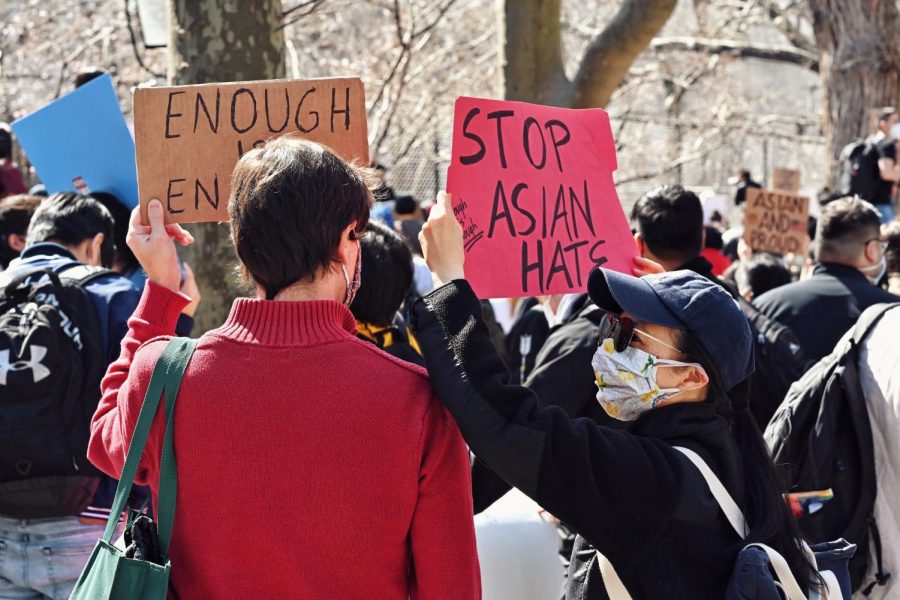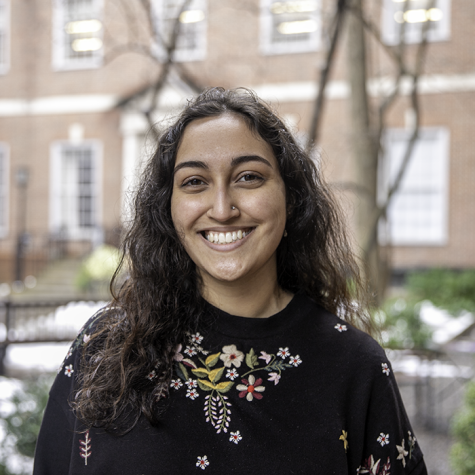‘So f-cking racist, it’s not even funny’: API students are frustrated with microaggressions from professors
Asian Pacific Islander students dealt with everyday microaggressions from professors long before pandemic-related hate. This article is the second in Sabrina Choudhary’s series documenting API students’ experiences with race at NYU.
The Stop API Hate campaign continues. Students recount incidents of microaggressions from professors. (Photo by Sirui Wu)
April 30, 2021
During the pandemic, Asian students have experienced hate from strangers in the city, ranging from nasty comments to drinks poured on them. While the Stop AAPI Hate movement has put a spotlight on these incidents, many of the Asian and Pacific Islander students I spoke to emphasized that microaggressions have been overlooked long before the pandemic. The students pointed to the fact that these microaggressions do not typically come from strangers in the subway, but from their own professors in the classroom.
Tisch junior Inaya Carroll is Canadian and biracial, half Indian and half white. Carroll says these kinds of microaggressions have been a pattern in the Drama department during the pandemic.
“In classes, especially in drama, unfortunately, the teachers are all old and white. And they will often confuse two Asian students for each other or call them the wrong name, or they’ll just say very out-of-pocket things,” Carroll said. “[A teacher] will just be like, ‘It must be hard to be Asian right now,’ and it’s like, you brought that up very weirdly, that could have been brought up with a lot more tact.”
While the Stop AAPI Hate movement created a conversation about physical violence and hate crimes, Carroll thinks everyday microaggressions are not discussed enough. These incidents also tend to be what API students worry about more on a daily basis — even those like Carroll, who aren’t being targeted by the attacks.
“Yes, the attacks should stop,” Carroll said. “[Professors] should also stop being microaggressive towards Asians, like little things about food and them looking the same, like we don’t… Asia is a big continent, not all Asians look the same even if they’re from the same country.”
Tisch junior Grace Santos is Japanese-American and is of Brazilian descent. Before the pandemic, a professor once praised her for playing a character that countered the “lotus blossom” trope of submissive Asian women. In doing so, he implicitly reinforced the stereotype.
“One professor — he got fired — but I did a scene where I played kind of like a feisty little sister character, and at the end he was like, ‘Oh, you’re not a typical submissive Asian girl, are you?’” Santos said. “Or, ‘You seem quiet, but I know you’re not.’ He meant it as a compliment, but he was being very weird.”
She also said that all of her drama teachers have confused her with a classmate, both before and during the pandemic.
“Teachers mix me up with the only other Asian kid,” Santos said. “She’s half Filipina, half white, [which is] entirely different. I don’t know, they always mix us up. Every teacher has mixed us up.”
She added that this is more frustrating in Zoom classes.
“Our names are literally right on the screen,” she pointed out via Instagram direct message.
Though the term “API” groups Asians and Pacific Islanders together, these groups have many distinct political struggles that come from different experiences of homeland, immigration, assimilation and colonization. Like many of the Asian students I interviewed, Gallatin senior Waikala Asuncion, who is Native Hawaiian, has also faced racism from their professors. They told me the story of correcting a professor who misused the Hawaiian word “mana” in one of his classes before the pandemic. It didn’t go well.
“I corrected his use of it because he was using it incorrectly, and also it’s one of my native languages, so I was like, I think I have the right,” Asuncion said. “You’re using this word in my native language wrong. I didn’t bring it up offensively, I was just like, ‘Hey, by the way, don’t think you’re using this word the way that you’re trying to use this word. This is what it actually means.”
For a student in this situation, calling a professor out is difficult. Asuncion felt that there was a lot of pressure on them to report this professor, especially since they were still in his class.
“To which this professor got very, very offended and then continued to harass me the rest of that semester and tell me that I was rude, my behavior was abhorrent, literally talking to me as if I was a high school delinquent,” Asuncion recalled.
This power imbalance can compel students of color to stay silent.
“I’ve had conversations with professors where they’ve told me, ‘Yeah, you can’t be the angry brown girl, or the angry brown person. You just can’t, you know, no one’s going to listen to you,’” Asuncion said. “And I’ve been like, wow that’s so f-cking racist, it’s not even funny.”
Even if students do report their professors, the NYU Bias Response Line isn’t always helpful. During the pandemic, Asuncion reported a different professor for anti-Latinx sentiment, and the hotline was slow to respond.
“He said how the Latinx community was responsible for spreading COVID in New York City, and I reported him to the bias hotline, right?” they said. “The bias hotline takes a month and a half to respond to me. At this point I have dropped the class, I have withdrawn, I am out of there… and then they keep consistently trying to pressure me into a meeting and I’m like, ‘Hey, I’m in the middle of class, I’m busy,’ and overall [they] just didn’t make it easy at all for me to be reporting this professor.”
Confronting a professor is especially difficult for students of color when their classmates don’t advocate for them. Asya Almukhamet, a Steinhardt junior from Kazakhstan, told me what one of her professors used the word “yellow” when listing examples of race. In a large Zoom lecture, she was the only person to correct him.
“No one said anything,” Almukhamet said. “We had like, three TAs in that class, we had 100-something people in that class, students. No one said anything. It was just me in the chat like, ‘Asian, not yellow,’” she said. “Were people okay with that? I wish someone had said anything.”
Santos is frustrated that microaggressions are often perceived by those who don’t experience them as isolated incidents rather than a pattern.
“When I do bring it up to my white friends sometimes, they only see that one instance, and they don’t see that there’s like a bunch of instances,” Santos said. “They’re like, ‘Why are you so worked up about that one thing?’”
She added that this type of dismissal has made her doubt the validity of her experiences.
“I always gaslight myself because I’ve just, I’ve gotten so used to it and it’s so normalized,” Santos said.
Carroll credited the surge of anti-Asian hate incidents and corresponding Stop AAPI Hate movement for beginning to draw attention to the normalcy of microaggressions.
“I feel like the Asian community has faced a lot of racism over the years that’s never really spoken about,” Carroll said. “And it’s terrible that it’s taken all these attacks and deaths for people to make a bigger deal out of it.”
Anti-API microaggressions were a problem before the pandemic, and they continue to interfere with students’ learning. Between NYU’s slow responses via its bias hotline, advisors pressuring students to challenge the people who determine their grades, and classmates acting as bystanders, API students are put in a corner each time they try to stand up for themselves.
Email Sabrina Choudhary at [email protected].

























































































































































